ESCAPE
The forbidden road to Leh
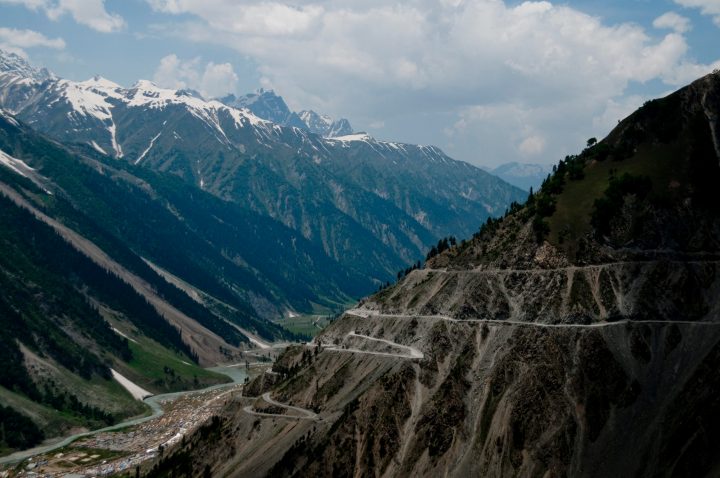
The road to Kashmir is closed to all but military vehicles and the possibility of war over India’s disputed territory with Pakistan is ever-present. But there was a brief moment in 2010 when a tense peace broke out and the scary switchback to Leh in the high Himalaya opened for civilian traffic. Don Pinnock took the gap.
The once-forbidden road from Srinagar into the Himalayas began for us along the shores of Dal Lake. As we threaded past tuk-tuk scooters and Tata trucks – avoiding children, scrawny dogs and sleepy cows – ghostly boatmen in gondola-like shikaras drifted through the dawn mist, mirrored in the still water. Leaving the lake, the pitted road wound up through scruffy villages clinging to the hillsides and crossed the Sind River swollen with snowmelt. Above us, achingly white against an impossibly blue sky, were the foothills of the highest mountains on Earth.
We were travelling in a window of opportunity. After the disastrous partition between India and Pakistan in 1947 in which more than a million people were killed, Kashmir became a contested state. Beautiful beyond measure, but remote and vulnerable – the most sparsely-populated region of India – it was invaded by China (1962) and Pakistan (1947, 1965 and 1999). By 2002, a million soldiers were facing each other across the Indo-Pak border. War was narrowly averted, though insurgency continued.
For decades Kashmir was off-limits to foreigners. Just then, however, there was a period of détente and the precarious road built by the Indian army from Srinagar through Kargil and Dras to Leh opened to travellers. It’s the second-highest motor road in the world, over 4,000m in places – narrow and with crazy hairpin bends, massive drop-offs and no retaining walls. Army convoys have right-of-way and exercise it without slowing down.
We had flown into Srinagar (soon afterwards to be riven by demonstrations and killing) from sizzling, overcrowded Deli under the intelligent, watchful eye of Mountain Adventures guide, Mohd Abbass. The town was once the summer capital of 16th century Mughal emperors. They adorned it with palaces and formal gardens with feet in the lake and heads beneath forested mountains. There they remembered the cold, dry deserts of central Asia and celebrated their good fortune at finding paradise.
A flotilla of shikaras had ferried us from the lakeside to sumptuous houseboats. By evening we were sipping tea on the broad deck watching beautiful women in colourful saris paddling silently through lotus blossoms cradled in the golden reflection of sunset.
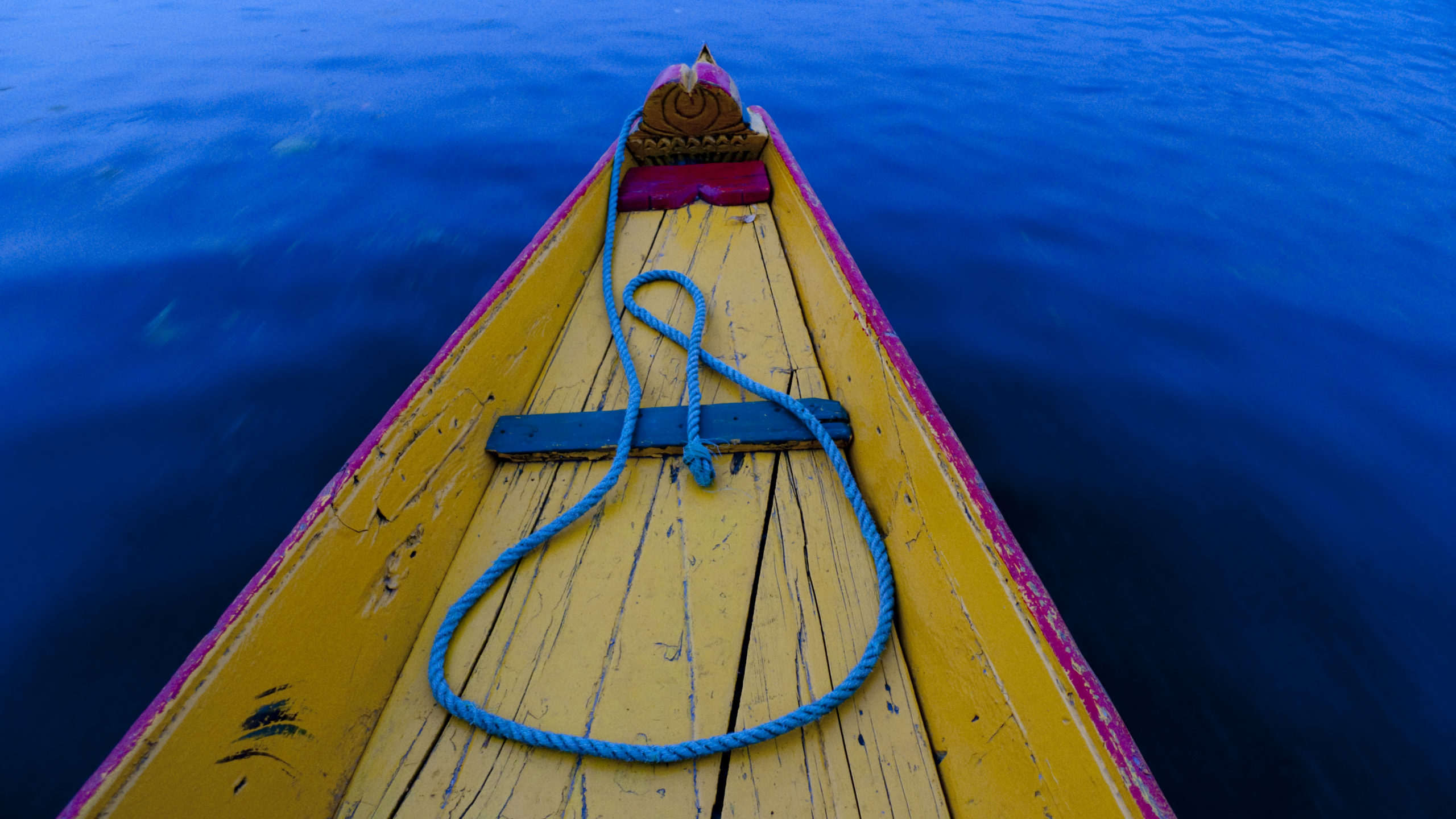
A Dal Lake ferryboat (Photograph Don Pinnock)
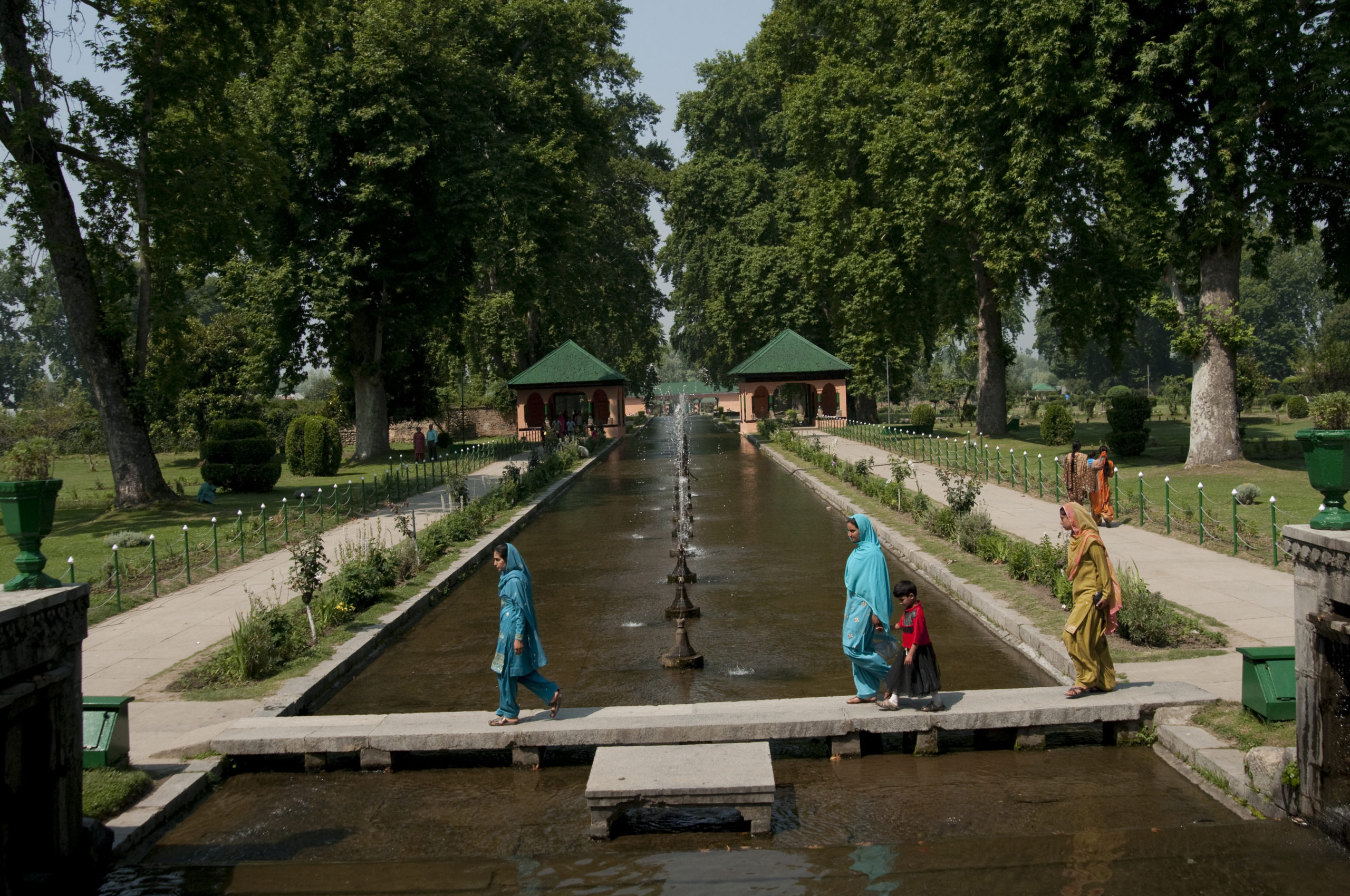
Srinagar was once the summer capital of 16th century Mughal emperors (Photograph Don Pinnock)
The houseboats, hangovers from the British Raj, are really floating palaces: 30m by 7m, intricately carved in cedar wood, floors covered with Kashmir rugs, ceilings dripping chandeliers, fans turning lazily and each with a private chef.
The next day we paddled along waterways past farmers and villages, visiting woodcarvers, papier-mâché painters, carpet makers and weavers of powder-soft pashmina shawls. It was hard to leave Srinagar, but the road beckoned.
I’d been warned of it by the writer Andrew Harvey, who asked a Frenchman who’d travelled the road to tell him what to expect. “I have been down the Amazon,” he told Harvey. “I have walked across the Kalahari. I once spent five weeks in the Sahara … and they are nothing like those two days going up from Srinagar to Leh. Find a patron saint and pray to him; don’t look too closely at the side of the road or you’ll faint or be sick. Take opium if you can get some. It helps.”
The road became a snaking, hairpin ledge hacked into mountain flanks.
As we rose higher and higher the air chilled, valleys fell away beneath the scrabbling wheels of our Toyota Qualis and white, insanely high peaks closed in around us. The road became a snaking, hairpin ledge hacked into mountain flanks. Glaciers shimmered in high valleys as we stopped for a picnic lunch beside a river. The water was so cold my hands were instantly numb as I dipped them in to wash.
As we busied ourselves with food packs, some scruffy but beautiful children approached shyly – sons and daughters of poor shepherds whose rough, plastic-covered huts we’d passed. We handed out some food and one youngster regarded the hardboiled egg in his hand with a wonder long lost to children of the urban lowlands. It was clearly the first egg he’d ever seen.
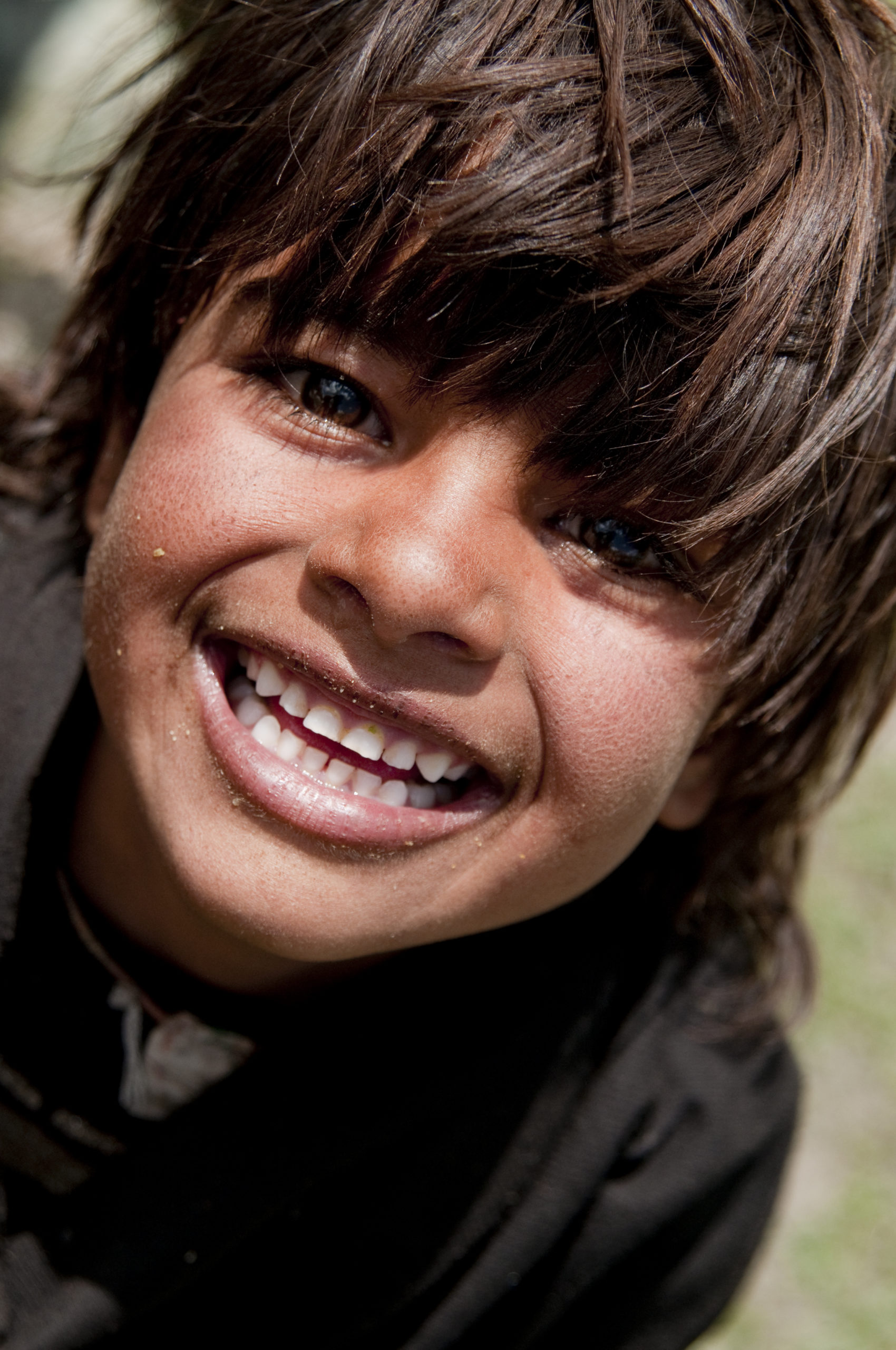
The happy recipient of a boiled egg (Photograph Don Pinnock)
Along the road was the occasional sign with exhortations to take care: “Road is hilly, don’t drive silly”, “If you’re married, divorce speed”, “Speed and safety never meet” and, rather puzzlingly, “Leave nothing, even your footprints”. Beside a particularly appalling section of track a sign read: “In process of making a world-class road.”
As we crested a watershed and dropped into the Himalayan rain shadow, the scenery changed abruptly from forests and streams to the harsh rock of the world’s highest ice desert. Nothing I had read or imagined prepared me for the splendour of that phantasmagoria of ice and stone. The vast rock wind palaces had been fashioned by time and immense forces into shapes that were impossible to believe. When we stopped, the silence was so truly stunned and sound-swallowingly breathless that words of description emerged from it very slowly.
I later read Harvey’s report of his ascent in A Journey to Ladakh and he had the same problem with words: “A river glimpsed there, a thousand feet below the road, its waters sparkling in the shifting storm-light, the path below on the bare rocky surface moving with sheep whose wool glittered in the sunlight, small flowers nodding in the crevasses of the vast rocks that lined the road … sudden glimpses of ravines pierced and shattered by the light that broke down from the mountains, of the far peaks secreted in shadow, or illumined suddenly, blindingly, by passing winds of light. They exist in a time of their own, as they are in their essence, in some final purity [that] words do not reach.’
No rain falls here and for more than half the year it’s blanketed by snow. There was hardly a plant in sight, but the colours of the Earth’s rocky bones went from volcanic black through reds, browns, oranges and greens to the eye-searing yellows of an area named, appropriately, Moonland.
At one point we were driving up a valley that formed the contested border between Kashmir and Pakistan. “Don’t take photos,” Abbass warned. “There are soldiers from both countries in bunkers on opposite hillsides here. You can’t see them, but they’re heavily armed and jumpy.”
We drove into Kargil in mid-afternoon, making our way down the busy main street to the Spartan, but clean, Hotel D Zojila. A Buddhist monk in Leh once told a traveller who inquired about the village: “I have no enemies. But if I did, I would wish them reincarnated in Kargil.” The Rough Guide describes it unkindly as a place of “grubby hotels that fill up at night-time with weary bus passengers, who then get up at 4am to career off under cover of darkness.” It’s there that the fiercest skirmishes of the Indo-Pakistan war took place. I rather liked the place, especially the clusters of women and old Ghandi-like men sitting outside little stores who stared at me unselfconsciously with no hint of judgement.
We left Kargil early after a breakfast of jammy japatis with strong tea and hit a traffic jam that would scare the hell out of a Gauteng minibus driver. The road is the only link between Kargil and Leh and is traversed by creaky busses, massive transport lorries and army trucks. Indian drivers are good, make no mistake, or they’d be dead long ago. But they’re hooter-besotted tailgaters who think nothing of driving mere metres behind a truck on a narrow hairpin track tooting to pass. I think it’s the one who hoots first who gets right of way, but can’t be sure. Trucks do move over, graciously allowing you to pass on blind rises or round sharp corners. I looked into the deep valleys and saw no wrecks, so the system must work. Amid all this, army convoys blasted through, leaving everyone covered in fine dust.

A military convoy on the road to Leh (Photograph: Don Pinnock)
We entered the region of Ladakh and stopped at a Buddhist gompa (“lonely place” or monastery) perched high above a valley. Lamas, ignoring our presence, chanted and struck gongs beneath ancient, watchful Buddha statues and colourful prayer flags. I sat beside an old fellow, closed my eyes and was swallowed into mindful emptiness by the deep resonance of his hypnotic drumbeat. My co-travellers had to drag me back to the vehicle and material reality.
Drās, which appeared several hours later, had a sign that proclaimed it the second-coldest place on Earth. We stopped at a restaurant which, just then, was filled by a pod of brave motorcyclists who’d arrived dust-brown on single-cylinder Royal Enfields. I used the restaurant toilet and wished I hadn’t. Perhaps that was the time for opium – to expunge the memory of its condition.
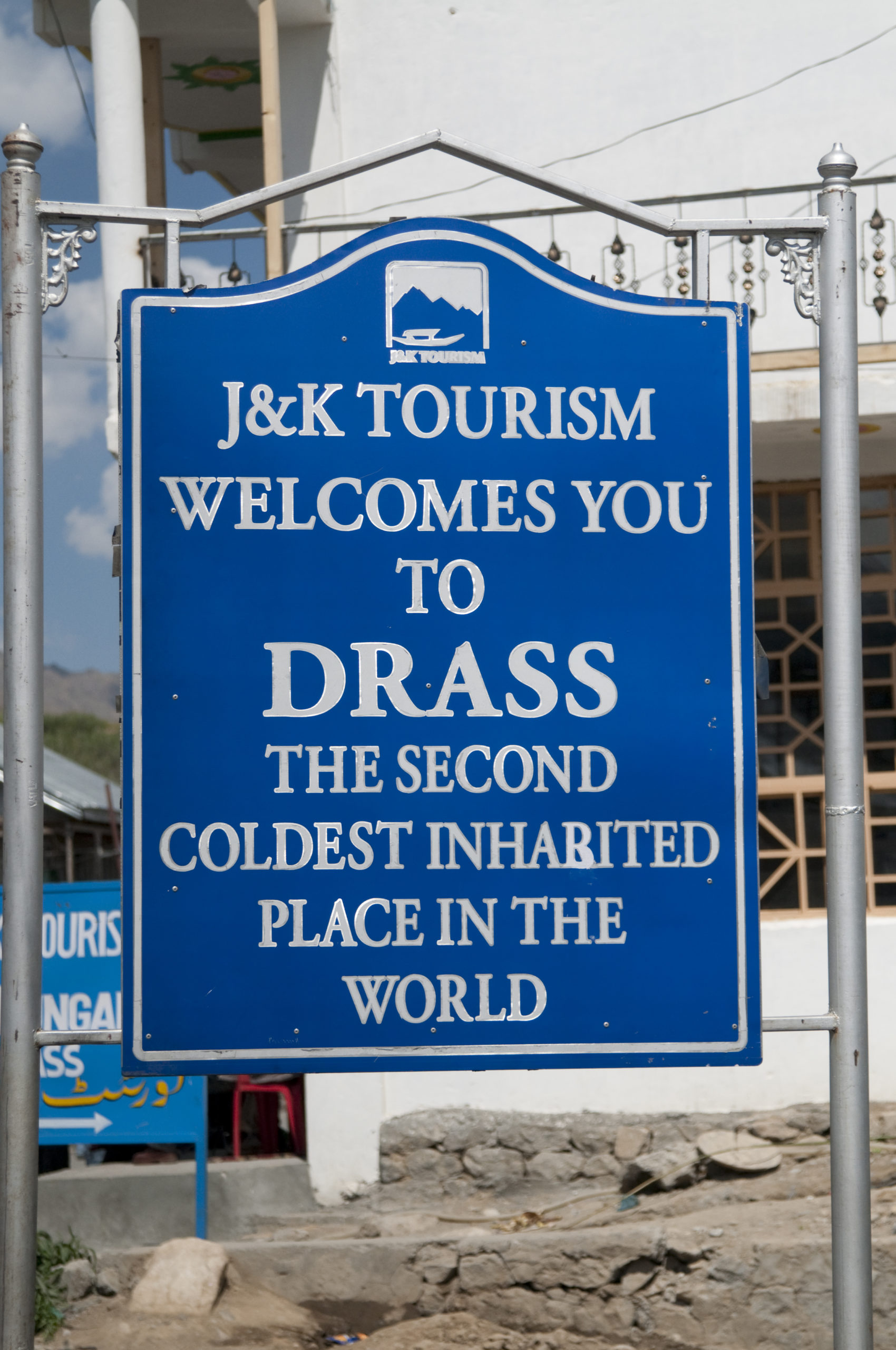
A warning, but the sun was shining just then (Photograph Don Pinnock)
It took us a few hours to get down Snake Pass, the next challenge, and it’s well named. The pass is a sinuous wonder of quixotic engineering which produced a monstrous traffic jam when a descending truck got stuck on a tight bend just as a military convoy was coming up. Finally disentangled, we cruised down a wearingly long valley lined with military camps and beneath mountains dotted with beetling monasteries into Leh.
The medieval town owes its existence to the old Silk Route over the Himalayas, connecting Tibet, China, Afghanistan, Punjab and Kashmir. It’s sustained by the proximity of the Indus River, which waters flows in summer and freezes in winter to provide an ice road to the lowlands. Leh is an ethereal, mysterious place on a cream-coloured desert plane rimmed by saw-toothed snowy peaks.
The first mention of the region seems to have been by the Greek historian Herodotus in the 5th century BC, who describes it as a land of wonderful ants. They were nearly as big as dogs and ferocious, he said. When they burrowed, they threw up gold that had to be fetched at night when they slept, and carried away on especially fast horses.
After centuries as a vital crossroads, its importance slowed with the partition of India and ended with the closure of the border in 1962 during the Sino-Indian war. It is easy to imagine, though, how the old trans-Himalayan traders must have felt as they plodded in on caravan routes from the Himalayas: a mixture of relief at having crossed the mountains in one piece and anticipation of a relaxing spell in one of central Asia’s most scenic and atmospheric towns.
When China invaded Tibet in 1950 and crippled religious life, Ladakh remained a centre of traditional Tibetan Buddhism. It’s a harsh land, but everywhere are small marks of human love and prayer. On each house, bridge or hilltop, ragged flags blow their prayers into the wind. Chorten shrines, looking like oversized white chess pawns and containing holy relics, bless the countryside. Everywhere there are prayer wheels, a few huge, many small and embedded in walls for passers-by to spin. High, wide mani walls, some a kilometre or more long, some short – all enclosing nothing – are everywhere. They were constructed over centuries and consist of polished mantra stones, each painstakingly carved with prayers or Om Mani Padme Hum (“Praise to the jewel at the heart of the lotus”). On a hill above the town is a huge, ruined, 17th century palace towering over a warren of red mud houses and markets selling finely crafted Tibetan and Kashmiri jewellery, clothing, carvings and food.
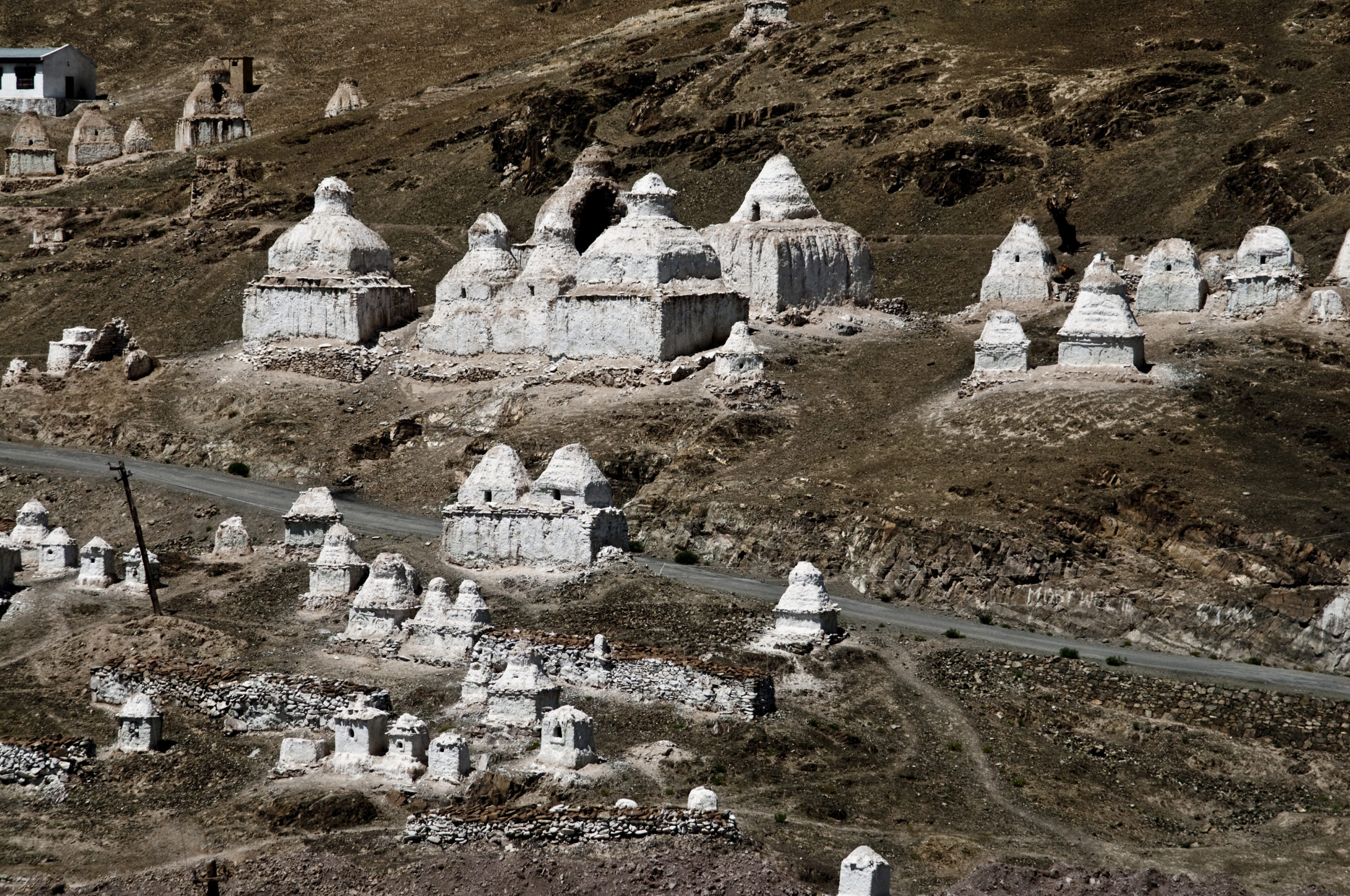
Chorten shrines at Leh on the ancient Silk Route (Photograph Don Pinnock)
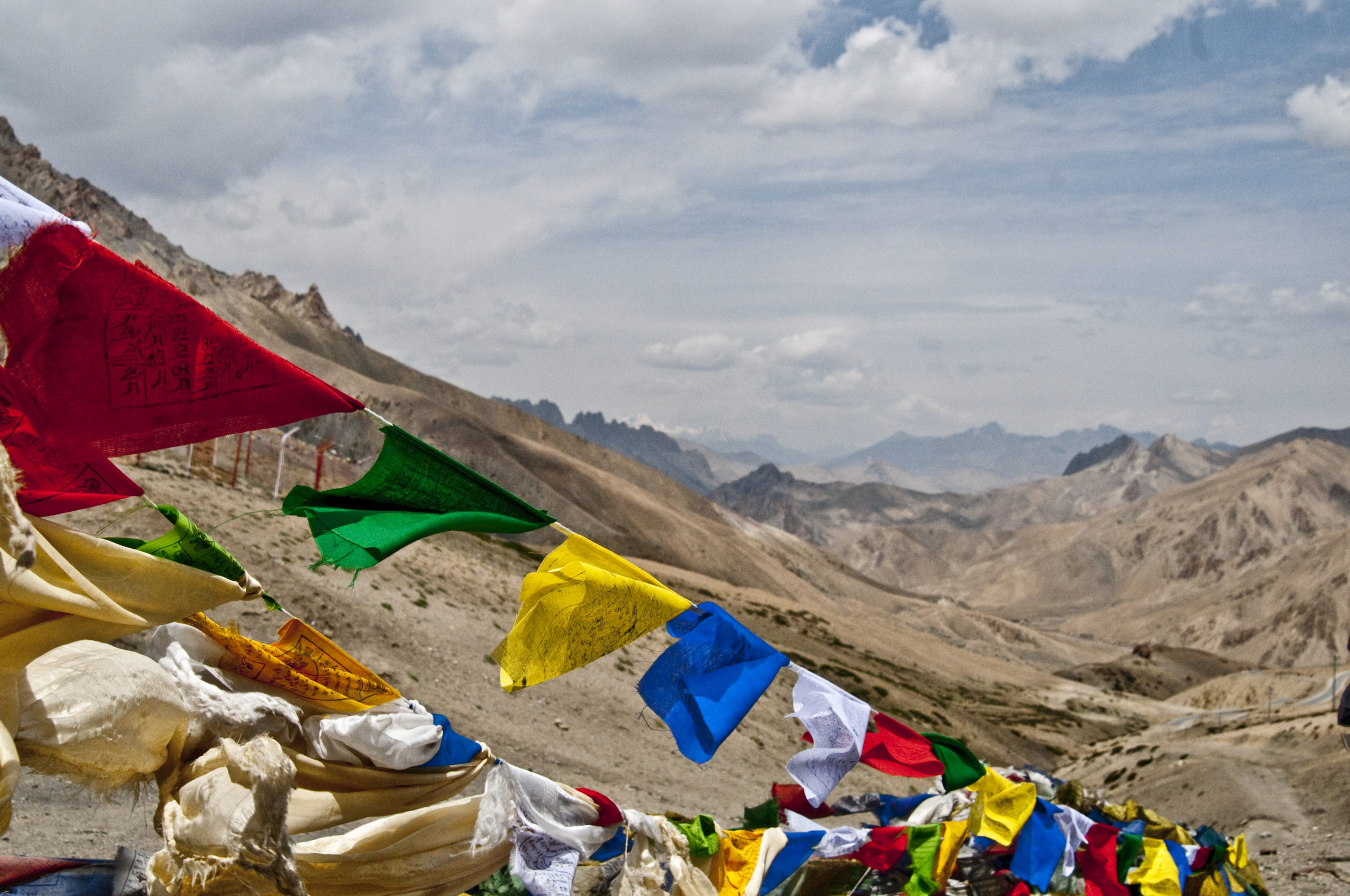
Flags mark the high pass into the Himalayas and the region of Ladakh (Photograph Don Pinnock)
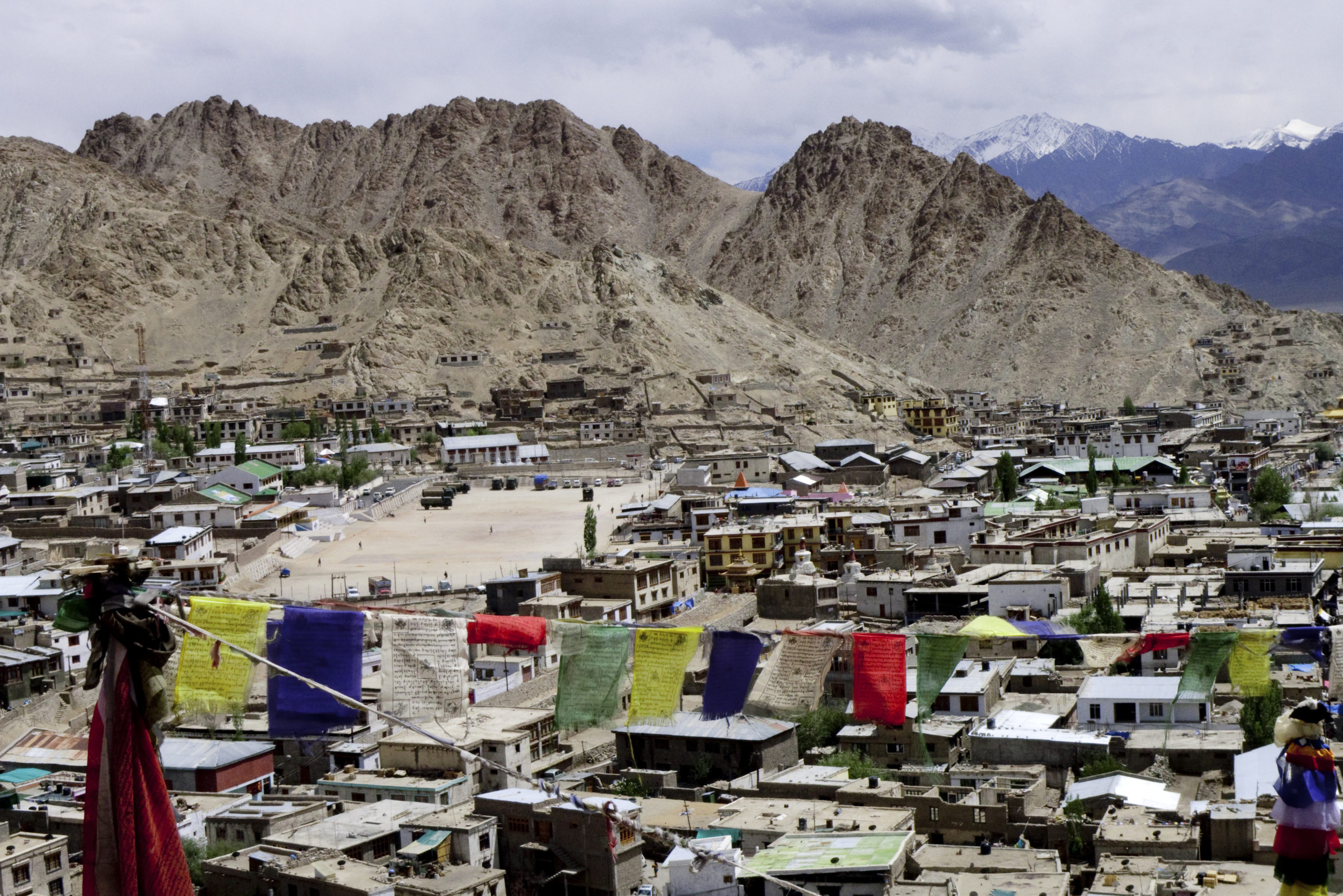
The high Himalayan town of Leh (Photograph Don Pinnock)
As I strolled around the town, people seemed peaceful and happy. They’re tolerant towards their old people, their children and each other. There’s almost no cruelty or theft and a bag or cellphone forgotten in a shop would undoubtedly be there the next day. They’re taught by their priests that every living thing has been their mother in a previous incarnation and must be respected as their mother. It’s hard to imagine a better belief for our environmentally aching planet.
All along the valley are Tibetan-style gompas occupied by devout, red-robed lamas. One of our goals was to attend the annual “devil-dance” festival at the Hemis Gompa – the biggest Buddhist monastery in Ladakh, some 45km southeast of Leh. Held on the 10th day of the Tibetan lunar month (late June or early July), it’s a celebration of the birth of Guru Padmasambhava, who is said to have rid the area of demons.
Its pieces were scattered in four directions, depicting, perhaps, the destruction of the troublesome ego or the cleansing of the soul after death.
The two-day pageant attracts around a hundred thousand locals and few tourists. We wandered up to the Gompa walls through busy market stalls, gulping the thin, breathless air (altitude 3,650m). Inside, a huge crowd had gathered round a courtyard centred by a flagpole. The crush of people was scary, but the gentleness of the Ladakhis was assuring.
Huge horns sounded, drums rolled, cymbals clashed and the chham dances began. Lamas robed in colourful garments with startlingly frightful masks performed mimes representing the progress of the individual soul and its purification in the triumph of good over evil. The dances ended with the ritual destruction by the dance leader of a human figure made of dough. Its pieces were scattered in four directions, depicting, perhaps, the destruction of the troublesome ego or the cleansing of the soul after death. The festival is a photographer’s dream.
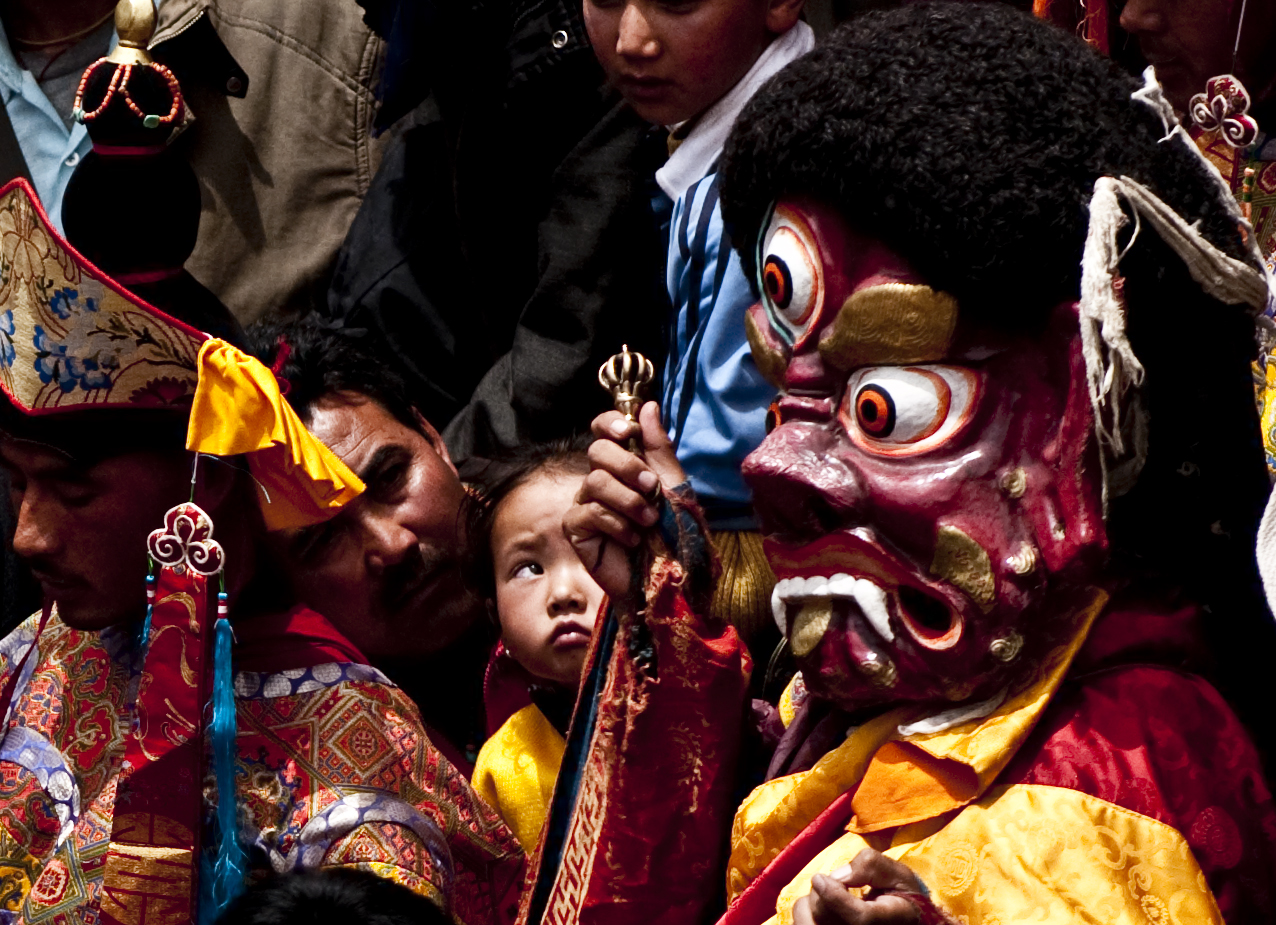
A ceremony to chase out the evil ego at a monastery near Leh (Photograph Don Pinnock)
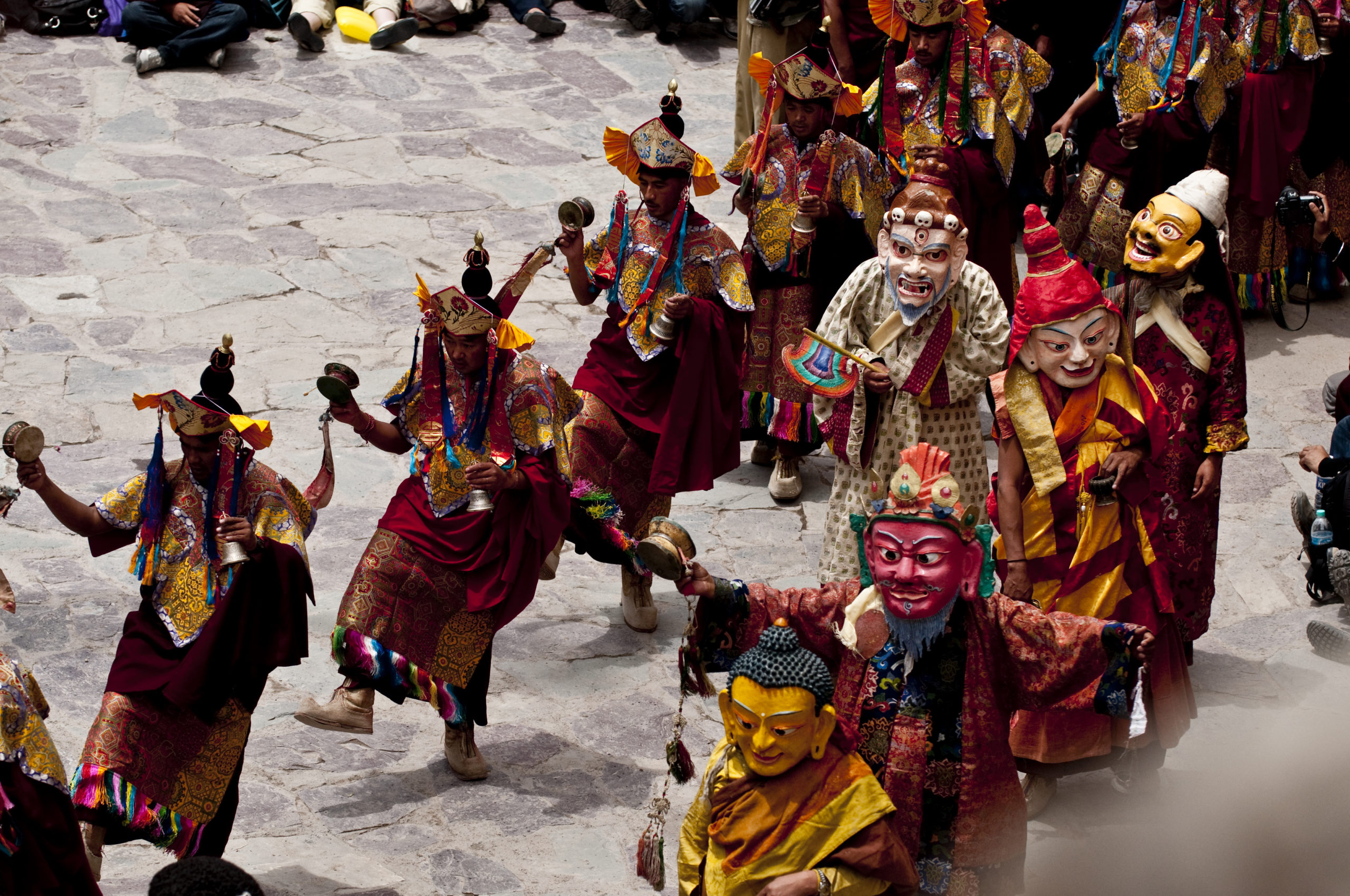
A ceremony to chase out the evil ego at a monastery near Leh (Photograph Don Pinnock)
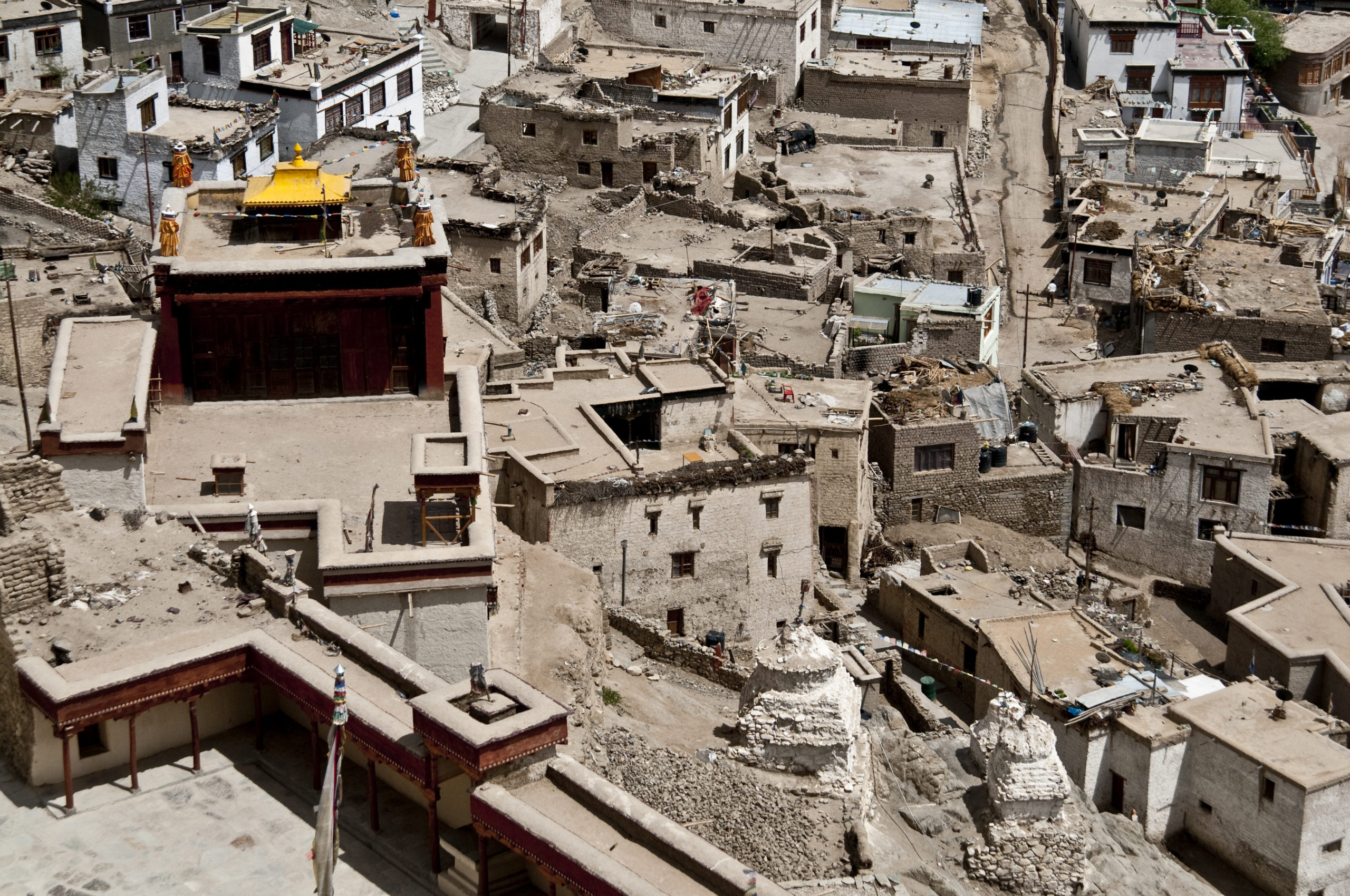
The high Himalayan town of Leh (Photograph Don Pinnock)
We visited several other Gompas – Lamayuru on the Kargil-Leh road is surrounded by soaring mountains, Spituk (a thousand years old) has a brooding presence and a roomful of devil masks, Thikse, built in the 15th century, contains a 14m-high, gold-clad Buddha-to-come (there are said to 1,000 Buddhas – 999 to go) – and Stok Palace, a museum where now-disenfranchised royals once lived. On the Gompa walls were paintings of wrathful and peaceful Tibetan deities in sharp, intense reds, whites, blues and golds staring at us with tender or terrible faces. After that we returned to Leh to engage in a few days of that most pervasive of rituals: shopping.
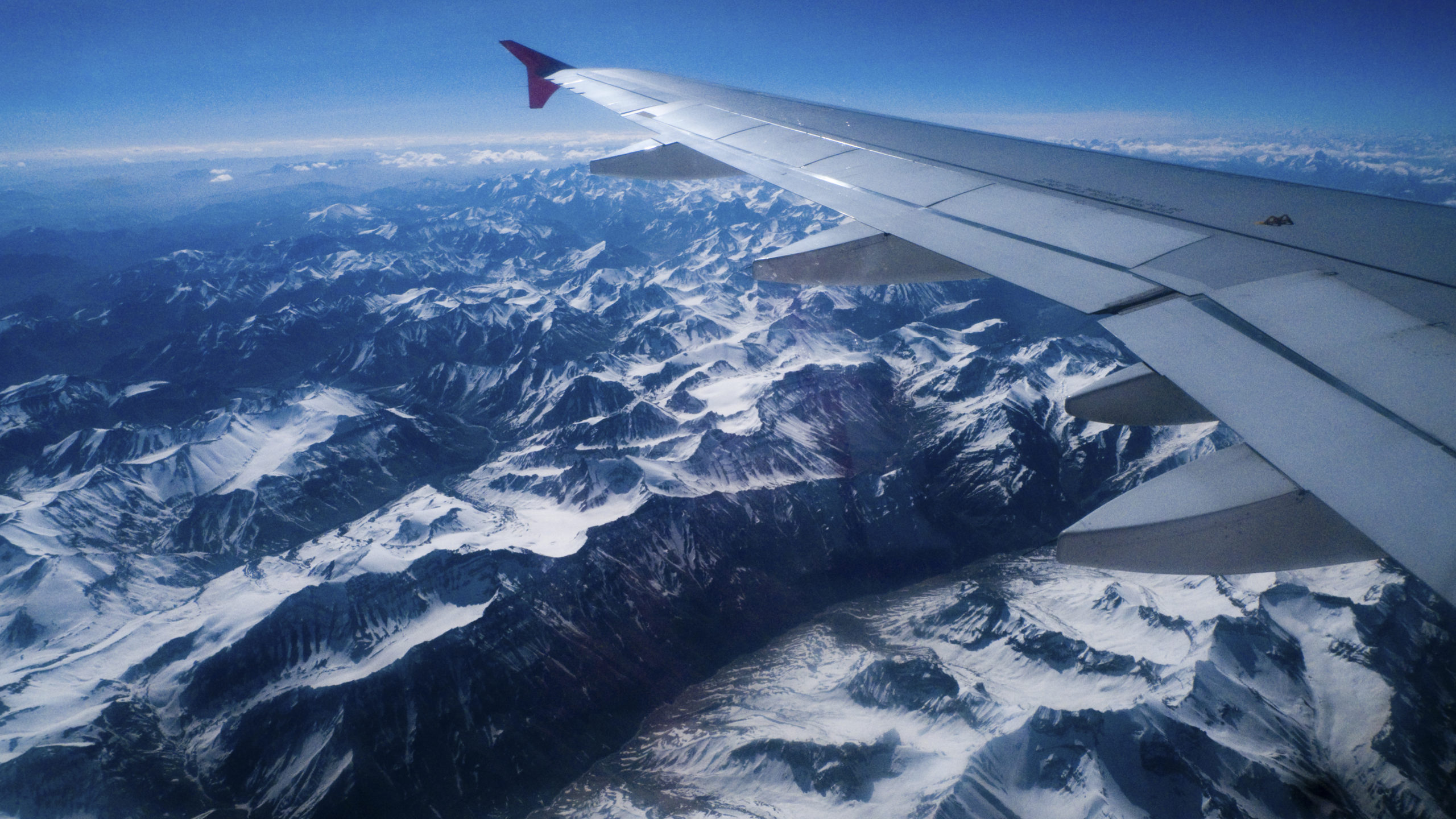
The Himalayas – a wilderness of mountains and valleys (Photograph Don Pinnock)
We left Ladakh on a commercial flight from the nearby military airport. In the thin air, the plane took ages to lift off the ground and just cleared the mountains surrounding the valley. As it climbed, the Himalayas unfolded their tortured white peaks all the way to the distant horizon; a scary, virtually unexplored wilderness. Somewhere down there, however, I knew there was a truck hooting to pass, an old lama endlessly beating a drum and a little boy who’d discovered the wonder of an egg. DM/ ML


















 Become an Insider
Become an Insider
Fascinating, thank you for sharing your experiences Don. Flashes of a trek I did in North Western Nepal about 20 years ago.
Thank you, Don for this beautiful piece. A reminder of another world way beyond the Zondo Commission, the SABC fiasco, and recalcitrant, corrupt politicians. More of this, please.
Don , great article . I did the same route 33 years ago , Vale of Kashmir , Srinagar , the house boats and the treacherous but spectacular road trip up the pass to Leh on the top (dogbox) of the supply trucks. Fascinating and beautiful.
What a great article. Nice to do some armchair travelling for a brief while.
A breathtaking, memorable account. More. more!!!